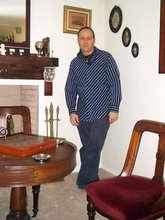
This morning started with mass at St. Michael's and All Angel's Scottish Episcopal Church in
Helenburgh. It is a beautiful Church, built in 1843. The people were very warm and welcoming when we arrived. I spotted a woman wearing a Third Order, Society of St. Francis Cross (my order) and identified myself by showing her my profession cross. She then introduced us to others. There are six Franciscan's (
TSSF) in the parish. After services we were invited for lunch in the parish hall. They were having a soup, cheese and bread lunch to benefit "Christian Aid UK." The food was wonderful and the people were very nice. They sat with us, talked, asked questions and showed a sincere interest. It was a wonderful experience. This picture is the front of the sanctuary area.

After a midday meal at St. Michael's, we headed for the highlands to find a whiskey distillery (Scotch). We found
Glengoyne. This photo is me in front of the waterfall that flows behind the distillery. Highland mountain spring water, along with
Scottish barley (golden promise and chariot varieties) and yeast are the only ingredients in the spirits they distill before barreling it for ageing. The barley is sprouted and air dried without the use of peat, hence the Scotch they produce is described as
unpeated. The distillery has been in operation since 1833 legally, although it is said to have been in operation before that. Changes in the law allowed it to become legal in 1833. Matthew and I were able to tour the distillery to see the whiskey being made and taste their 10, 17, and 21 year old single malt scotch whiskey's today. We both agree the 17 year old was the best. Some critics seem to agree. It was awarded the Gold Medal by Scotland's Master Blenders in the prestigious International Spirits Challenge 1999 and again in 2005. It was named "Best of the Best" in the Highland Malt Whisky category by Whisky Magazine in 2001. It also received the Double Gold in the San Francisco World Spirits Competition in 2003 and took honors in 2005 and 2007.

This photo shows the copper
stills used to distill the spirits used to make
Glengoyne's whiskeys.







 This morning started with mass at St. Michael's and All Angel's Scottish Episcopal Church in
This morning started with mass at St. Michael's and All Angel's Scottish Episcopal Church in 
























 Below is another photo from the castle showing the city below. The grouse (yellow flowers) are in full bloom all over Scotland at the moment.
Below is another photo from the castle showing the city below. The grouse (yellow flowers) are in full bloom all over Scotland at the moment. 



